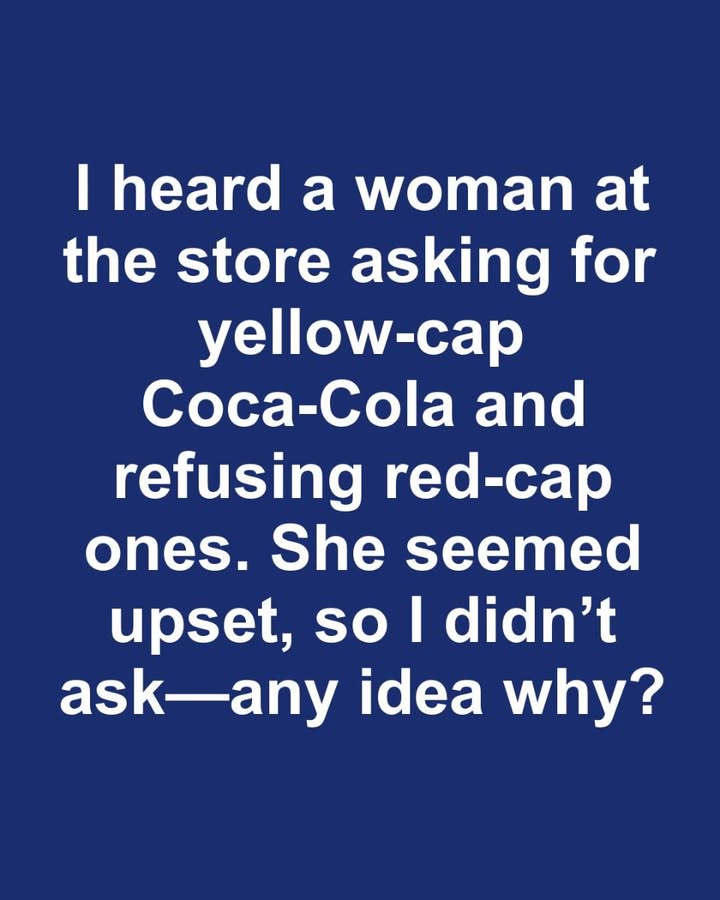While shopping at my local grocery store, I couldn’t help but notice a woman urgently requesting Coca-Cola with a yellow cap, completely refusing to even consider the red-cap bottles. Her insistence and clear frustration caught my attention, and although I was tempted to ask what made the yellow-capped version so important, I chose not to intrude on her personal moment.

Still, the situation lingered in my mind and led me to wonder: what is the actual difference between Coca-Cola bottles with red caps and those with yellow ones? Until that day, I had never really paid attention to the cap colors, assuming they were just a design choice or a seasonal variation, but it turns out there’s a much deeper reason behind it. Coca-Cola, being the global brand that it is, often uses different colored caps to signify variations in product content or purpose, and in some cases, to meet specific cultural or religious needs. Most people are familiar with the classic red cap, which typically represents the standard Coca-Cola made with high fructose corn syrup. However, the yellow cap carries a special significance that many may not be aware of—it indicates that the beverage is kosher for Passover. During the Jewish holiday of Passover, observant individuals avoid consuming products that contain leavened grains or ingredients derived from grains, such as corn. Since the regular Coca-Cola formula in the U.S.
includes high fructose corn syrup, it is not considered kosher for Passover. To accommodate these dietary laws, Coca-Cola creates a special version sweetened with cane sugar instead, which is considered acceptable during Passover. This version is marked with a yellow cap to clearly distinguish it from the standard product and help consumers identify it easily. While some people choose yellow-cap Coca-Cola for religious reasons, others may do so for personal preference. Many individuals believe that the cane sugar version tastes better or more like the original Coca-Cola recipe before corn syrup became the standard sweetener in the 1980s. The flavor profile of cane sugar is often described as smoother and less syrupy, and it evokes a sense of nostalgia for those who remember the old formula. In fact, some fans of the yellow-cap version go out of their way to find it each year when it’s available, even buying it in bulk because of its limited seasonal release. Others view cane sugar as a healthier or more natural alternative to high fructose corn syrup.
Although the health benefits of cane sugar over corn syrup are still debated, the perception that cane sugar is less processed and more natural drives many people to prefer it. For people with sensitivities to certain ingredients, the yellow-cap option may also feel like a safer or more suitable choice. Coca-Cola has a long-standing practice of adapting its product to regional and cultural preferences.
In some countries, such as Mexico, Coca-Cola is regularly sweetened with cane sugar, and bottles imported to the U.S. are sought after by enthusiasts for their unique taste. The yellow-cap Coca-Cola produced for Passover reflects the same principle—modifying the product to meet the values, preferences, and dietary needs of a particular group. Beyond taste and health reasons, the yellow-cap Coca-Cola has also become something of a collector’s item or a special treat due to its limited availability. Since it’s only produced around Passover, consumers often feel a sense of urgency to grab it while they can. Marketing strategies that highlight exclusivity or seasonal releases often succeed in creating hype, and Coca-Cola certainly benefits from this phenomenon. What started as a religious accommodation has grown into a popular and even coveted product, appreciated by a wider audience. So, reflecting on that moment in the store, the woman’s demand for yellow-cap Coca-Cola now makes complete sense. Whether her preference was tied to faith, taste, health concerns, or just familiarity, it goes to show that even a small detail like the color of a bottle cap can hold deeper meaning. It’s a reminder that consumer choices are often influenced by more than just branding—they’re shaped by culture, experience, and personal values, and sometimes, they even tell a story that’s richer than we realize.





